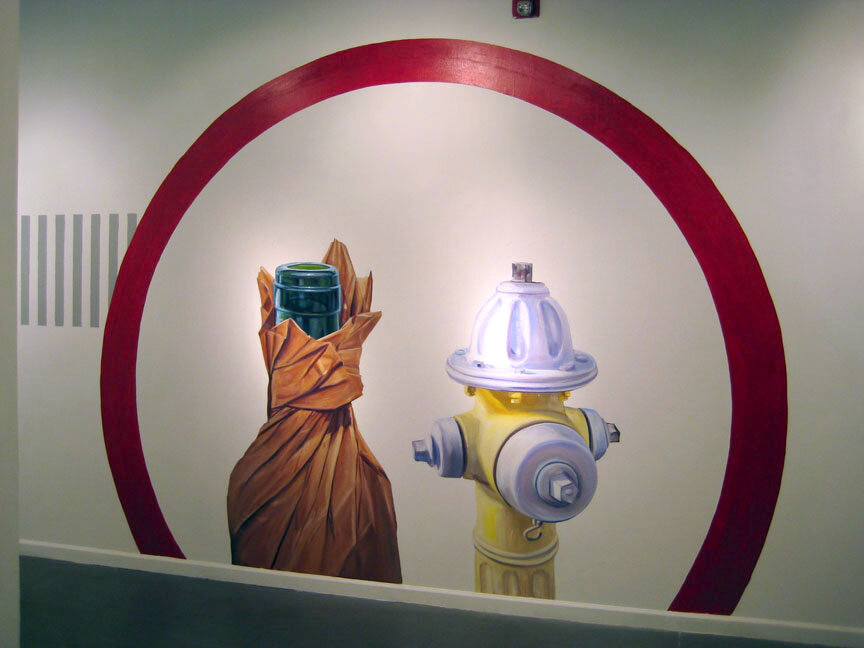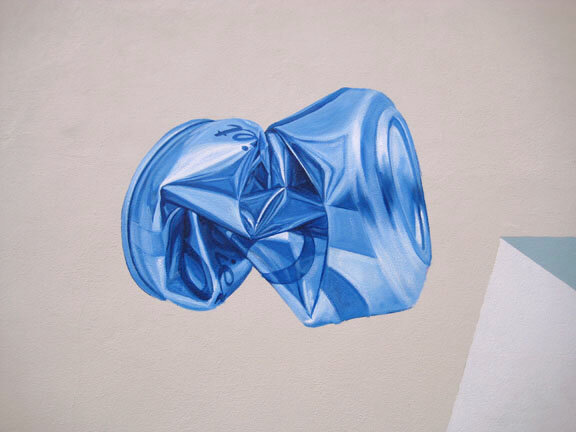Self Control
Redux Contemporary Art Center, 136 St. Philip St. reduxstudios.org
Review in the Charleston City Paper by Nick Smith
While ancient Greek and Roman murals are venerated in the art world, contemporary wall paintings lack a fine art cachet. Maybe it's the sanitized public nature of many large-scale murals that puts off the art toffs — those WPA-inspired images of trains and townsfolk that are heavy on local significance and thin on technique.
But that large scale attracts some artists to the form, despite the red tape they have to cut through to obtain municipal blessing for their work. Jeff Zimmermann is one such artist, painting big and bold for every passerby to see. He's not the type to hide a gouache away in a dark corner and leave it at that. He likes to impress with lots of content, sometimes cramming in whole cross-sections of the communities he observes.
With his penchant for big pictures, Zimmermann could be regarded as a modern day showman, striving to grab our attention in a world where we've learned to tune out the boasts and billboards around us. In person, however, Zimmermann is amiable and fair-minded. The approachable Chicago native is inviting the public to follow his progress during his two-week Redux residency, which runs through May 20, as he adds pop art touches to the interior and exterior of the building.
"When I'm sitting and staring there, it looks like I'm not doing anything," says Zimmermann with typical insouciance. "I'm working. Thinking of what the end experience will be for people. It's never the same experience. The space dictates the way it reveals itself."
Hence, the sitting and staring.
Zimmermann's keener than most to see things from the viewer's perspective.
"Advertisements and other visual garbage are the competition for my murals," he says. "But I'm not trying to sell anything. And a lot of my work has so much going on in it that it's not propaganda, not a one-liner. You'll be able to revisit my work. The people who tune it out, they're not my audience."
Because of its pop culture origins, Zimmermann's work does have some Ad Land origins. His subjects wear primary colored clothes, hopping from paintings like Gap commercial gimps. Disembodied heads float across his scenes, smiling at the latest gizmos. Icons like Jiminy Cricket hobnob with local treasures, painted with passion and honesty. Deep red and blue backgrounds help to imbue the blandest walls with shifting, shimmering life. Surprisingly, this eye-popping work often complements its surroundings — the corporate logos, gas pipes, and satellite dishes that adorn our world.
"I like it if it fits in with what's already there," says the artist. That extends to the neighborhood around Redux. "I'm painting no history of Charleston, just allusions, some local likenesses to help me convey what I'm trying to convey." Zimmermann will stick to a five-10 block radius for inspiration. "That way the content of my work will be more authentic."
Whoever turns up in the paintings, they'll be shown on a grand scale.
"I have friends who live in New York with studios the size of a compact car. In Chicago, I can work giant. Those size of paintings are impressive to me. I can move my arm around a lot more loosely, get into the act of painting with my full body. I enjoy that. It's what comes naturally. I'd rather do that than scratch away at a canvas."
The downside: "There's a small market for people who can hang 10 by 10 foot paintings." Which is where residencies like the Redux program come in. They give Zimmermann carte blanche to do what he wants — the title Self Control is a wry comment on this — and continued validation in a society where mural snobs continue to exist.
"There are a couple of fine art institutions that don't take me seriously," the artist admits. "But I get a lot of support from galleries and communities. My audience is so wide, even though I don't consciously try to be trendy. Eventually my work will become fashionable."
Like those classical murals, Zimmermann needs a little time to pass before his paintings are fully appreciated. Meanwhile, we get to enjoy his creative process and his colorful, widescreen take on our neighborhoods.















